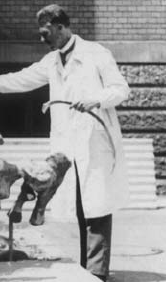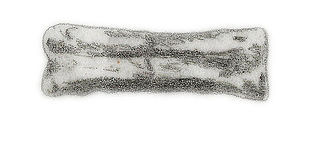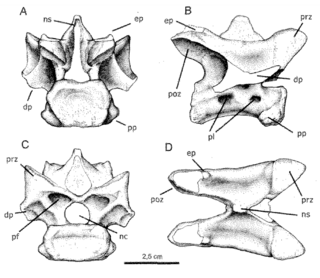Succinodon putzeri (meaning "narrow jaw") was the scientific name given by German paleontologist Friedrich von Huene to a fossil that he attributed to the sauropod family Titanosauridae. It was discovered in late-Cretaceous rock near Warsaw, Poland, in 1941. He believed it to be a jaw bone.
In 1981, however, an analysis by Polish paleontologists Krystyna Pożaryska and Halina Pugaczewska showed that the specimen was actually a piece of fossilized wood filled with the burrowings of wood-boring bivalves in the family Teredinidae, most likely in the genus Kuphus . [1]

Megalosaurus is an extinct genus of large carnivorous theropod dinosaurs of the Middle Jurassic Epoch of southern England. Although fossils from other areas have been assigned to the genus, the only certain remains of Megalosaurus come from Oxfordshire and date to the late Middle Jurassic.

Compsognathus is a genus of small, bipedal, carnivorous theropod dinosaur. Members of its single species Compsognathus longipes could grow to around the size of a chicken. They lived about 150 million years ago, during the Tithonian age of the late Jurassic period, in what is now Europe. Paleontologists have found two well-preserved fossils, one in Germany in the 1850s and the second in France more than a century later. Today, C. longipes is the only recognized species, although the larger specimen discovered in France in the 1970s was once thought to belong to a separate species and named C. corallestris.

Friedrich von Huene, born Friedrich Richard von Hoinigen, was a German paleontologist who renamed more dinosaurs in the early 20th century than anyone else in Europe. He also made key contributions about various Permo-Carboniferous limbed vertebrates.

Thecodontosaurus is a genus of herbivorous basal sauropodomorph dinosaur that lived during the late Triassic period.

Titanosaurus is a dubious genus of sauropod dinosaurs, first described by Richard Lydekker in 1877. It is known from the Maastrichtian Lameta Formation of India.

Procompsognathus is an extinct genus of coelophysid theropod dinosaur that lived approximately 210 million years ago during the later part of the Triassic Period, in what is now Germany. Procompsognathus was a small-sized, lightly built, ground-dwelling, bipedal carnivore, that could grow up to 1 m (3.3 ft) long.

Antarctosaurus is a genus of titanosaurian sauropod dinosaur from the Late Cretaceous Period of what is now South America. The type species, Antarctosaurus wichmannianus, and a second species, Antarctosaurus giganteus, were described by prolific German paleontologist Friedrich von Huene in 1929. Three additional species of Antarctosaurus have been named since then but later studies have considered them dubious or unlikely to pertain to the genus.
Podokesaurus is a genus of coelophysoid dinosaur that lived in what is now the eastern United States during the Early Jurassic Period. The first fossil was discovered by the geologist Mignon Talbot near Mount Holyoke, Massachusetts, in 1910. The specimen was fragmentary, preserving much of the body, limbs, and tail. In 1911, Talbot described and named the new genus and species Podokesaurus holyokensis based on it. The full name can be translated as "swift-footed lizard of Holyoke". This discovery made Talbot the first woman to find and describe a non-bird dinosaur. The holotype fossil was recognized as significant and was studied by other researchers, but was lost when the building it was kept in burned down in 1917; no unequivocal Podokesaurus specimens have since been discovered. It was made state dinosaur of Massachusetts in 2022.

Teinurosaurus is a genus of carnivorous theropod dinosaur. Teinurosaurus lived during the Late Jurassic in what is now France. The type species is Teinurosaurus sauvagei. It's been estimated to be 11.4 m in length and 3.6 tonnes in weight.

Fulgurotherium is a dubious genus of ornithischian dinosaur from the Late Cretaceous (Cenomanian) Griman Creek Formation. It lived in what is now Australia.

Indosaurus is a genus of carnivorous theropod dinosaur that lived in what is now India, about 69 to 66 million years ago during the Maastrichtian division of the Late Cretaceous. The species I. matleyi weighed roughly 700 kg (1540 lb).
Halticosaurus (pron.:"HAL-tick-oh-SORE-us") is a dubious genus of theropod dinosaur from the late Triassic period. It is known from a single fragmentary fossil specimen of the species H. longotarsus, found in the Middle Stubensandstein formation of what is present-day Germany The only known specimen was poorly preserved and may have been put together from bones of unrelated animals. Further research would be required to determine which of the bones belonged together, and what kind of theropod Halticosaurus was. However, most of the bones have been lost. For these reasons, Halticosaurus is considered to be a nomen dubium.
Clasmodosaurus is a genus of titanosaurian sauropod dinosaur from the Bajo Barreal Formation. It lived during the Late Cretaceous in what is now Argentina. It is known only from three fossilized teeth, and is therefore a tooth taxon. It is a nomen dubium.

Efraasia is a genus of basal sauropodomorph dinosaur. It was a herbivore which lived during the middle Norian stage of the Late Triassic, around 210 million years ago, in what is now Germany. It was named in 1973 after Eberhard Fraas, who during the early twentieth century collected what were the original type specimens.

Thecospondylus is a dubious genus of dinosaur from the Early Cretaceous of England. Scientists are unsure as to whether Thecospondylus was a saurischian or an ornithischian.

Palaeosaurus is a genus of indeterminate archosaur known from two teeth found in the Bromsgrove Sandstone Formation and also either the Magnesian Conglomerate or the Avon Fissure Fill of Clifton, Bristol, England. It has had a convoluted taxonomic history.

Laevisuchus is a genus of theropod dinosaur from the Late Cretaceous. Its remains were discovered by Charles Alfred Matley near Jabalpur in Maastrichtian deposits in the Lameta Formation in India, and were named and described by paleontologists Friedrich von Huene and Matley in 1933. The type species is Laevisuchus indicus. The generic name is derived from Latin laevis, "light" and the Greek name for the ancient Egyptian crocodile god, Soukhos. The specific name means "Indian" in Latin. It is known only from three cervical vertebrae and a dorsal vertebra. A holotype was not assigned by Huene and Matley and a lectotype has never been chosen from the syntypes. All remains except GSI K27/696 were lost; GSI K20/613 was rediscovered in 2012.

Sphenacodon is an extinct genus of synapsid that lived from about 300 to about 280 million years ago (Ma) during the Late Carboniferous and Early Permian periods. Like the closely related Dimetrodon, Sphenacodon was a carnivorous member of the Eupelycosauria family Sphenacodontidae. However, Sphenacodon had a low crest along its back, formed from blade-like bones on its vertebrae instead of the tall dorsal sail found in Dimetrodon. Fossils of Sphenacodon are known from New Mexico and the Utah–Arizona border region in North America.
Kuphus is a genus of shipworms, marine bivalve molluscs in the family Teredinidae. While there are four extinct species in the genus, the only extant species is Kuphus polythalamius. It is the longest bivalve mollusc in the world, where the only known permanent natural habitat is Kalamansig, Sultan Kudarat in the Philippines.
Apatosuchus is an extinct genus of non-crocodylomorph loricatan pseudosuchian known from the Late Triassic of Germany. It is known from a partial holotype skull from the middle Stubensandstein in Baden-Württemberg. The type species is Halticosaurus orbitoangulatus.A. orbitoangulatus was first described by German paleontologist Friedrich von Huene in 1932, who considered it a species of the theropod dinosaur Halticosaurus. Some later studies proposed that it was an early crocodylomorph or "sphenosuchian" like Saltoposuchus, another pseudosuchian from the middle Stubensandstein of Baden-Württemberg. The name Apatosuchus, "deceptive crocodile", was erected for H. orbitoangulatus by Hans-Dieter Sues and Rainer R. Schoch in 2013 when it was realized that the known material represented a pseudosuchian archosaur rather than a dinosaur, as a result of further preparation of the specimen, coining the combinatio novaApatosuchus orbitoangulatus. Apatosuchus is now thought to be a basal member of the clade Loricata. Apatosuchus is much smaller in size than other basal loricatans such as Teratosaurus and Batrachotomus.